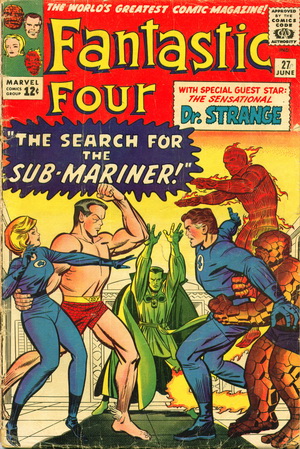
Published: June, 1964
Script: Stan Lee
Pencils: Jack Kirby
Inks: George Bell
Letters: Sam Rosen
Since this blog approaches Marvel comics from a female point of view, it’s likely this post will make observations about this highly explosive episode in the ongoing saga between the Fantastic Four and Sub-Mariner that have never been made before. This is a great story! But the underlying theme is that, sometimes, when it’s most important, men do not know how to communicate. If they did, we wouldn’t have all this ongoing drama. They say women are drama queens? Huh! This time, guys, it’s all on you.
We start our tale with Reed testing his new Thought Projector Helmet, which displays, for all to see, the helmet-wearer’s innermost visions. I’m sure Marvel readers down through the ages have gotten a kick out of this device. The first thing we see is Reed thinking about Sue…in a bathing suit…a one-piece bathing suit…wearing shoes. Yeah, not only does he censor his thoughts enough to think of her in a one-piece bathing suit, but he also puts her in shoes. I know this is a family-friendly title, so she has to be wearing some sort of clothing…but shoes? Really?
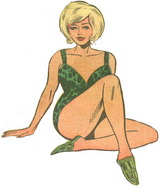 Though, come to think of it, I don’t know if I’ve yet seen bare feet in Marvel comics—normal, human feet, that is, not superhuman mutated monstrosities of feet. Maybe the same Comics Code that insists Sue be in a one-piece bathing suit also puts shoes on her feet?
Though, come to think of it, I don’t know if I’ve yet seen bare feet in Marvel comics—normal, human feet, that is, not superhuman mutated monstrosities of feet. Maybe the same Comics Code that insists Sue be in a one-piece bathing suit also puts shoes on her feet?
How obliging of Reed to confine his innermost thoughts to Comic Code approved images.
Anyway, the real point here is Thing’s immediate comment: “Whataya know?! So his brain AIN’T just a mess of test-tubes and six-syllable words!” That phrase pretty much sets the stage for the rest of the story. Our mild-mannered scientist, who almost never reveals his true feelings, is about to go nuclear!
And it will be fun to watch. But also frustrating.
After some playing around with the Thought Projector, Sue leaves, and Reed announces to Thing and Torch that he’s going shopping…for an ENGAGEMENT RING! I guess in Fantastic Four #1, when Sue describes herself as Reed’s fiancée, it was only wishful thinking on her part. Or maybe it was a carefully crafted plan to fluster him into allowing her to join that fateful space flight into the cosmic rays.
Or, maybe there’s another explanation. We already know Reed is much more comfortable using six-syllable words to talk about test tubes than he is in making declarations of love. Perhaps in his failure to communicate, Sue has gotten a completely erroneous idea about the state of their relationship.
But Reed’s seeing much clearer now. Who knows what he imagined Sue wearing before? A turtleneck sweater, overalls…and galoshes? So perhaps he’s now more in touch with his true feelings about the blonde beauty, Sue Storm. And at last, he is ready to “pop the question.” He goes shopping, comes back with the engagement ring,  and bubbles over with jubilation about his proposed proposal…until he discovers that Sub-Mariner has kidnapped Sue!
and bubbles over with jubilation about his proposed proposal…until he discovers that Sub-Mariner has kidnapped Sue!
Now Reed is in a rage. And such a rage we have never seen before! Yes, I guess our stoic scientist does have emotions, and he gives a good display of them now, flinging his elongated limbs all over the lab, as he vows to make Namor “PAY for this…with his LIFE!” Even Johnny and Thing are surprised by Reed’s outburst, reminding him to simmer down because “it’s shamefully undignified!”
When Reed gets hold of himself, he searches for Namor on his Radar-Sweep-Ray, which covers the surface of the entire planet like a fine-tooth comb. Which leads to my first question: how does that work, exactly? Does the Sweep-Ray know exactly what to look for, and hones in on it with scientific precision? Or is it only providing an image of every frickin’ detail of the entire surface of the planet, like some giant Where’s Waldo game? If Reed has to look at EVERYTHING on the planet in order to find Namor and Sue, he may not recognize them when he finally succeeds—because by that time, they’ll be gray and wrinkled!
Though Torch and Thing have been forbidden by Reed to assist, they call in Dr. Strange, to help on the “hocus-pocus” front. Neither seems entirely convinced Dr. Strange actually exists, and show surprise when he finally makes an appearance, walking through the wall.

 By the way, Dr. Strange looks exceptionally handsome here in his ectoplasmic form! Russ says he thinks Strange is channeling Clark Gable, but frankly, my dear, I have to wonder if the air in upper Manhattan agrees with him more than the air of Greenwich Village? Or, perhaps he’s benefiting from a Jack Kirby beauty treatment?
By the way, Dr. Strange looks exceptionally handsome here in his ectoplasmic form! Russ says he thinks Strange is channeling Clark Gable, but frankly, my dear, I have to wonder if the air in upper Manhattan agrees with him more than the air of Greenwich Village? Or, perhaps he’s benefiting from a Jack Kirby beauty treatment?
Strange uses his own version of a Radar-Sweep-Ray, his ever-powerful amulet, to track down Namor in his underwater castle, at about the same time Reed enters through the castle’s unlocked back door.
Now, here’s where things really get interesting.
Strange observes, as we do, Namor making his plea to Sue. The King of Atlantis only desires 24 hours to plead his case, to make the surface woman see that she should choose him over Reed. After all, Namor notes, he has never had the “chance to date” her, the way Reed Richards has. See? He’s not really a bad guy kidnapper. He just wants one thing: a DATE.
Okay, I have to admit, at this point, Sue is not communicating, either. When Namor says he wants 24 hours “to tell you how I love you…to ask you to be mine!!” Sue responds with “But Reed will find you! And when he does…nothing can save you!”
It probably would have been better if she chose this moment to deliver her wonderful “Let’s be friends” speech from page 22, but give the girl a break. She’s been knocked out, kidnapped, held prisoner in a glass bubble at the bottom of the ocean. Certainly, she does not consider Namor a rational being who can be reasoned with, so it’s not surprising that all her thoughts are focused on what Reed will do when he finds her.
Namor’s reaction to Sue’s threatening predictions? “So!! STILL you torment me! Am I NEVER to know…is it Reed Richards…Or is it me you love?”
That’s a pretty straightforward question, and one that deserves an answer. But so quickly, Reed arrives on the scene, or at least his elastic arm enters, stage left, entrapping Namor like a boa constrictor. (And by the way, I thought it was pretty funny when Sue sees the long blue arm and exclaims, “Reed! It’s YOU!” No, honey, it’s that OTHER guy in a blue costume who can stretch his limbs like a boa constrictor. )
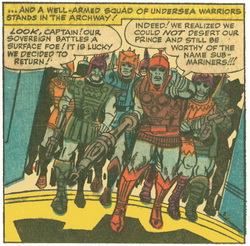 And now begins page upon page of obligatory fight scenes. Reed and Namor challenge each other in every way possible, each exhibiting his strength in turn, until reinforcements show up, and the battle grows even more intense. Namor’s small army of warriors, who deserted him earlier because they felt their leader was wacko for wanting to marry a surface woman, returns now, declaring, “We realized we could NOT desert our Prince and still be worthy of the name Sub-Mariners!!!” Yes, three exclamation points, but this also raises another question: are all the Atlantean warriors “sub-mariners”? I thought Namor was THE Sub-Mariner. His men seem to think they’re Sub-Mariners too. Perhaps someone in the know could clear this up for me?
And now begins page upon page of obligatory fight scenes. Reed and Namor challenge each other in every way possible, each exhibiting his strength in turn, until reinforcements show up, and the battle grows even more intense. Namor’s small army of warriors, who deserted him earlier because they felt their leader was wacko for wanting to marry a surface woman, returns now, declaring, “We realized we could NOT desert our Prince and still be worthy of the name Sub-Mariners!!!” Yes, three exclamation points, but this also raises another question: are all the Atlantean warriors “sub-mariners”? I thought Namor was THE Sub-Mariner. His men seem to think they’re Sub-Mariners too. Perhaps someone in the know could clear this up for me?
At the same time, the forbidden-to-appear Torch and Thing also appear, courtesy of some Dr. Strange hocus-pocus, and while Thing fights the warriors, Torch frees his sister. There’s further commotion involving a Remote-Controlled Spy Camera the size of Michigan, as well as Electro-Stun Guns, and later, an Undersea Blast Gun. This story’s got all the toys!
But in the end, it comes down to this: two fellas fightin’ over a gal.
They both fight nobly, for they’re both noble fellas, and the prize is worth fighting for. But beyond that, it’s a fascinating fight, full of insightful moments.
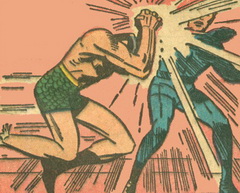 Namor, like us, is not used to seeing Reed Richards let his emotions get the better of him, and when he observes that “Mr. Fantastic can explode in a fit of rage like anyone else,” he gains new respect for his rival. “Perhaps now,” Namor taunts him, “you can understand MY feelings,” citing his distress when the accursed humans caused him to lose his kingdom, his people, everything he holds dear.
Namor, like us, is not used to seeing Reed Richards let his emotions get the better of him, and when he observes that “Mr. Fantastic can explode in a fit of rage like anyone else,” he gains new respect for his rival. “Perhaps now,” Namor taunts him, “you can understand MY feelings,” citing his distress when the accursed humans caused him to lose his kingdom, his people, everything he holds dear.
Are these two finally connecting on some deeper emotional level? Might they finally be coming to the realization that the other is not “the bad guy,” but that he’s also fighting, with equal conviction, for that which he holds most dear?
Namor goes on to ponder what a pity it is that he and Reed are mortal enemies, because “together, we would be unconquerable!!” Could you imagine? The regal strength of Sub-Mariner teaming up with the unstoppable smarts of Mr. Fantastic? To even THINK such a thing blows your mind!
Of course, this moment of understanding is all too brief, for it’s quickly followed by Namor’s realization: “But, that can never be!” Yeah, we know. And why? Because, as Namor later figures out: “We live by different codes!”
That’s the crux of it all, isn’t it? They live by different codes. One on land, the other by sea. One a king, the other a citizen of a democracy. It’s sort of amazing that it took Namor so long to figure this out. But it’s encouraging that at least now he recognizes Reed is not being stupid, cruel, or obstinate. He recognizes that he and Reed are brothers in their search for what is most edifyingly noble…brothers, yes…but brothers of different mothers.
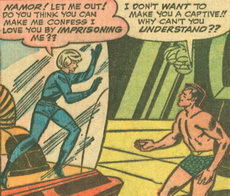 And all of this could have so easily been avoided. Right? If Namor had taken a few moments to acquaint himself with human customs and think about how his actions were likely to be perceived before enacting his crazy plan to kidnap Sue and drag her down to the bottom of the ocean for 24 hours of brainwash-dating, he could have avoided a lot of complications. Maybe he should have started out by putting on a suit and tie and “accidentally” running into Sue at the coffee shop? From there, he might loan her a book about Jacques Cousteau. That would surely lead to some pleasant conversation. Maybe in his world a monarch grabs a woman by the hair and drags her down to his undersea castle, but a human woman in this liberal age… not so keen on that treatment.
And all of this could have so easily been avoided. Right? If Namor had taken a few moments to acquaint himself with human customs and think about how his actions were likely to be perceived before enacting his crazy plan to kidnap Sue and drag her down to the bottom of the ocean for 24 hours of brainwash-dating, he could have avoided a lot of complications. Maybe he should have started out by putting on a suit and tie and “accidentally” running into Sue at the coffee shop? From there, he might loan her a book about Jacques Cousteau. That would surely lead to some pleasant conversation. Maybe in his world a monarch grabs a woman by the hair and drags her down to his undersea castle, but a human woman in this liberal age… not so keen on that treatment.
And that woman’s human boyfriend, even less so.
Namor’s problem is that he thinks he’s the center of the universe. He thinks everyone has to conform to his way of thinking. And I hate to say it, but that’s Reed’s problem, also. As a rule, Reed functions from a place of science and logic, and when that’s your foundation, why would you look any further for explanation and meaning about how the world works? Reed thinks he has all the answers, and he doesn’t have patience for any mindsets that are not as enlightened as his.
So, that’s my point about men not communicating. But wait, there’s more. I mentioned earlier that Sue has a wonderful moment on page 22 when she finally comes right out with it, in no uncertain terms. Let’s listen in:
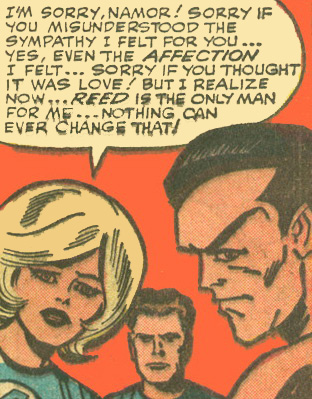
So, even though in the past, Sue’s spent some valuable time hemming and hawing, trying to eeny-meeny-miney-moe her decision between Reed and Namor, all that’s behind her now. She makes a bold declaration of her feelings…in front of everyone! Namor, Reed, Johnny, Thing, even Dr. Strange, who’s been observing the dramatic undersea tableau via what appears to be a crystal ball.
Namor said he would be willing to accept Sue’s decision, but he hasn’t yet had his entire 24 hours with her (and unfortunately he wasted the first hour or two of their special time together beating up her boyfriend), so as Dr. Strange notes that Namor’s “rage is mounting,” and “He is capable of ANYTHING!” the benevolent doctor mystically whisks the Fantastic Four out of danger.
Now they’re back in the sub, heading home. And this is when we get one last-minute kink in the story. Listen closely.
“Sue, darling,” Reed begins, “about what you said back in Namor’s palace…”
Dot dot dot. He’s handing her the ball. And what does she do with it?
“Please, Reed! I-I’d prefer not to discuss it now! I’m still so shaken!”
Understandably. But….
She’s not saying I don’t ever want to talk about it again. She’s just saying, hey, can we hold off until I’ve had a chance to put on my jammies and pour myself a glass of wine? In case you haven’t noticed, it’s been a tough day.
How does Reed feel about that? We may never know. Because the lunkheaded Thing decides to butt into something that’s none of his business, asking Sue, “Hey! You didn’t just say what you did in order to prevent any more fighting, did you?”
Huh? What? Why?? WHY? Why couldn’t he just keep his big mouth shut!
Now, Reed’s a pretty smart guy, and he may have eventually come up with that EXCUSE himself for avoiding further intimacy. But Thing hands it to him on a silver platter. And he TAKES it!!
Barely skipping a beat, Reed exclaims, “NO! Don’t answer that, Sue! I think I’d rather not KNOW your answer!”
Thing is not the only lunkhead in this scene.
 WHAT is going on here in the less-than-fantastic thought processes of Mr. Fantastic? Earlier in the story, he felt confident enough to buy Sue an engagement ring. He was ready to give it to her before the interruption of this little fiasco…which, by the way, ends with Sue confessing her love for him in front of EVERYONE. Now, he should feel more confident than ever, but instead, he develops feet of clay and retreats back into a place of “uncertainty and anguish,” gripping the wheel of the submarine with knitted brow.
WHAT is going on here in the less-than-fantastic thought processes of Mr. Fantastic? Earlier in the story, he felt confident enough to buy Sue an engagement ring. He was ready to give it to her before the interruption of this little fiasco…which, by the way, ends with Sue confessing her love for him in front of EVERYONE. Now, he should feel more confident than ever, but instead, he develops feet of clay and retreats back into a place of “uncertainty and anguish,” gripping the wheel of the submarine with knitted brow.
Okay. I started out saying this was all about men’s inability to communicate, but my girl Sue, in the next to the last panel, establishes herself as the third lunkhead in this scene. “Oh, Reed, you blind fool!” she thinks, “Of course it’s you l love!! But how can I ever CONVINCE you?”
Well, I can think of one way. Sue’s words are encased in a thought bubble, not a word balloon. I understand she’s feeling stressed after everything that’s just happened, but what she needs to do right now is straighten out the curvy edges of that thought bubble and turn it into a word balloon.
Talk. Communicate. Don’t keep it all inside, honey. Tell your man how you feel. Again. And again, if need be. And you might have to tell him again and yet again, but at some point he’s bound to HEAR you and BELIEVE you, and jump out of his self-protective shell of uncertainty and anguish.
There’s a shiny little bauble he bought you, way back on page six, but you can’t enjoy it, unless somebody in this group starts figuring out when to shut up, and when to speak out.
I wouldn’t hold out too much hope for the menfolk, Suzy. It might have to be you.
| Want to read this comic on your computer? Marvel has a scan! Want to own this story? Buy the Masterworks! |















Superb! Wonderful! Bravo!
In Ben’s defense, I wonder if his final interjection was calculated? My theory is that Reed is autistic (I can give a long list of reasons). I don’t mean that in a bad way: I am diagnosed on the spectrum myself, and Reed is my hero. I think Reed finds relationships confusing and exhausting, and FF 27 is where the stress reaches unbearable levels. I imagine his mind as a swirling maelstrom of confusion, overwhelmed with too many data points. Being overwhelmed pretty much defines autism.
Neuro-typical (NT) minds are tuned for social situations. Social situations are far more complex than most people realize: every new variable doubles the complexity, and pretty soon you have thousands of “what if”s. What if Sue does “this”? What if “that” happens? What if “X” then happens? What if, at that point, “Y” happens? NT minds quickly discard the unlikely scenarios and focus on the ones that are likely to matter. So they can carry on an emotion-laden conversation in real time, and even enjoy the stimulation! But to an autism-spectrum (AS) brain, the experience is VERY different.
To the AS mind each data point has equal weight until all possible scenarios are calculated, and it becomes overwhelming. Worse, when surrounded by NTs who can easily keep up, AS people have a desperate feeling of other people can see things you cannot. And they need love just as much as other people. Love is like air. But when NTs swim and frolic, AS people drown.
The water metaphor in Fantastic Four 27 is absolutely inspired. And of course water is Freudian imagery for sex.
To understand how Reed is feeling at the end of FF 27, imagine the opposite situation. Imagine you were the only NT in a group of AS people who were all electronics experts. Imagine you had a ticking bomb, and had to defuse it in the next five seconds. (The ticking bomb for Reed is loneliness without Sue: he cannot survive without her, as we shall see in the 1970s, which culminates again in the oceans) To the AS experts the bomb is absurdly simple: any child could stop it. Isn’t it obvious? The task is fun! “Can’t you see that resistor and that NAND gate? Just disconnect wire A”! Obviously!!! It’s so simple, just do it!!! And you stare at the mass of wires and hear the ticking and you reach a blind panic and have a meltdown. I think that’s how Reed feels at the end of FF 27. He knows that his mental survival depends on saying the right thing to Sue, he knows it is obvious to everyone else, he has to say the right thing RIGHT NOW and he can’t cope!!!
Ben sees Reed flailing, and with compassion he steps in to give Reed a get-out: at this point Reed just needs time, a way out of the conversation. Reed was panicking inside and Ben saved him.
Reed then drives home in silence. I find driving in silence is so therapeutic. The problem with autism is the feeling of being overwhelmed. Not knowing if you are doing the right thing, not knowing how to respond. But when driving a car everything is well defined and relatively simple. As long as you focus on the road (and people on the spectrum are very good at focusing) you can forget everything else and know you are doing The Right Thing for the duration of the journey. Driving is very calming. Big hearted Ben just saved his best friend, which is all the more poignant given how Reed had (unintentionally) hurt Ben over the previous two years.
As for why Sue does not just say “I love you” I think that reflects the beautiful, powerful depth of the story. Yes, she could say “I love you” enough until he gets it. She could led him by the hand her whole life. But is that what she wants? To be married to an emotional two year old? Is that the marriage and future she wants? She desperately needs Reed to do something to show he is not emotionally crippled. She needs him to be able to recognise her love without her acting like mother and spoon feeding a toddler. She loves him, but that life would be too much. Sue spent her life since her early teenage years raising Johnny. She does not want another child. She wants to be a child herself! She never had a proper childhood: emotionally she cannot cope with being a child, then raising a child then marrying a child. She wants a man!!!
With Sue’s looks she could get any man she wants (note the recurring motif of Hollywood producers wanting her). No wonder Sue was tempted by emotionally strong Namor. (It is no accident that Namor has his own movie studio, seen in FF 9 and FF 195: it is sending the same message, instead of spoon feeding babies her whole life, Sue deserve to be pampered, to be a babe herself, to finally have a childhood and girly things: what choice will you make, Sue?). But in FF 27 when Namor stalks and kidnaps her, Sue has to face the reality: Namor could never be her husband. That leaves Reed, but he can be such a helpless child – is there no way out?
I love how, in this trapped under the sea story, Sue, Red and Ben are all trapped in their minds in different ways. (And Johnny as well, but that’s another topic.) I love the subtlety and depth, the oceans of drama below the surface. Thankfully we the readers are not tormented forever. In the following issue Reed shows he CAN be more than a child, emotionally. It is no accident that he proposes when at his old school, where he feels emotionally most confident.
Talking of sea symbolism, I want to say a few words about dragon man, who appears when Reed finally proposes. Namor’s love is represented by monsters of the sea, so rocket scientist Reed’s love is represented by a monster of the air: a terrifying dragon who has the mind of a child and loves Sue. Dragon man’s appearance in FF 35 foreshadowing the three future possibilities in marriage: will marrying Reed be like marrying a dragon? This was the early 1960s when plenty of women were trapped with angry men they regretted marrying. Or will Reed be an emotional child? Or will he be the third iconic image of Dragon man, the symbol of power who soars in the sky, carrying Sue (and in FF 134 her baby too) in his arms? Dragon man always accompanies marriage crisis: he appears when Reed and Sue get engaged, he has his greatest moments in the honeymoon, he takes Sue and the baby when they separate, and finally he appears when Johnny marries Alicia. but I’m getting ahead of myself.
I love the depth of these comics, and I love your blog post. Thank you!
Chris,
Thanks for your astonishingly well-reasoned answer to Chrissy’s recent post. She’ll be along in a little bit to respond. I wanted to take a moment to apologize for butchering your comment.
I take great pains to ensure that Chrissy doesn’t get spoiled by anything that might happen to our favorite characters in future adventures, or any future revelations about a character’s past. Please keep in mind that Chrissy has only read those stories she’s written about so far, and I want her to have the same experiences of joy and discovery and surprise that you and I had, when we first read these stories. That’s part of the charm of this blog. There are plenty of blogs by folks who are going back and REREADING the stories for the thousandth time, and writing of their observations, with the benefit of hindsight. Blogs by people who are reading Silver Age stories for the first time? Not so many.
Your insightful comments are still 100% intact, and for those who want to read them in their entirety, you simply have to swipe your mouse over the missing blocks. But Chrissy, alas, can’t be exposed to them yet.
Thanks again for reading, and sharing!
No problem! I didn’t realise she was reading them fresh: I envy her! I live in Britain, so discovered the FF in bit and pieces. The issues between 12 and 44 were the hardest to find, so I read them last, long after I read the 200s (this was back in the 1980s). So these issues will always be the most special to me. It must be wonderful to read the first time in the order they were intended Maybe that’s why this blog is so fresh and insightful.
Wow! What great insight! Your example about the bomb experts really struck home, really made me see your point. I may have to agree with you about Reed being somewhat autistic. Now that I’ve been exposed to this idea, I think it might explain a LOT about him.
Of course you realize that from this point on, as I read, I’ll be keeping this in mind. I don’t know if that’s what Stan and the other Marvel writers intended when they created these characters 50 years ago. I mean, 50 years ago who besides doctors and psychiatrists had ever even heard the word “autistic”? But I imagine back in the 1960’s there was some understanding that great, smart scientific minds behaved differently than “ordinary” minds, and I feel these stories capture that notion, not only in our superheroes, but also in many of the villains.
As Russ explains below, I missed a few lines in your comments, to avoid being spoiled regarding future events, but even so, your hypothesis holds together very well. When you said “Reed finds relationships confusing and exhausting,” and I just had to chuckle. I think you’re so right!
As for Ben compassionately providing Reed with a “way out,” that makes so much sense in view of their great friendship. In some ways I find “Thing” can be a lunkhead, but as for Ben Grimm, as far as I’ve seen him so far, he’s always been a stand-up kind of guy.
Please continue to comment on these blog posts! It’s great to get different perspectives, especially from people who have so much background and experience with Marvel comics!
Chrissy,
Another excellent job analyzing this issue. I enjoyed your take on Reed and his lack of communication, along with your thoughts on Namor’s character, both of which I believe are spot on. I loved the line about Namor buying Sue a Jacques Cousteau book! And you’re correct, men can often be much worse drama queens than women, I’ve seen this is action (and have been guilty of it myself from time to time!).
The Namor/Reed/Sue triangle was a strong ongoing plot winding its was through the early FF stories, but I’ll be interested in your observations on future developments.
Jacques Cousteau. 1960’s. Sub-Mariner. This stuff writes itself.
As I’m continuing to read through Marvel comics, I’m finding that the stories I most enjoy are the ones with the greatest amount of drama and soap opera. Sure it’s great to see the super battles between superheroes and super-villains, but to me that’s just the BACKDROP to the real story: who’s having an emotional crisis, and how are they going to deal with it?
The Sue/Reed/Namor triangle is one of my favorite ongoing stories. Whenever I get to the next FF issue and see those highly arched eyebrows and emerald green swimming trunks, I clap my hands together and say, “Oh goody!”
Regarding the Atlantean warriors calling themselves Sub-Mariners … When Bill Everett created Namor back in 1939, he named Namor’s underwater race Sub-Mariners, not Atlanteans. In fact, Everett never called their underwater city Atlantis, either. That was Stan Lee’s doing, many years later, in FF Annual #1, I believe.
So, yes, all Atlanteans are Sub-Mariners — it’s sort of their name for their race, though you don’t see writers using it much anymore, as Atlantean has supplanted Sub-Mariners in the Marvel Universe. And Namor is The Sub-Mariner, much like Connor MacLeod is The Highlander.
Just found your blog, and since I enjoyed this review, I intend to read more here.
Thanks for the history! Since there is such a deep history for this character, it makes sense that the answer would not be a quick and easy one, but you have shed some light. Thanks!
And…glad to have you on board, please chime in any time!
I can’t stop reading, Chrissy. I’m writing a superhero novel, featuring the Butterfly, inspired by “What if?” conversations about Stan’s late Spider-Man stories with my friend known as Nate Adler from the blog “How To Fix…?” Strong female characters were always an opening for the genre’s evolution, artistically. Someone posted a link over on Fnord12’s SuperMonkey site, I think, and your viewpoint on ASM #17, from its apt name onward, shed the social clunkiness of its Spider-centric trappings, hooked me by exploring the deliciously rich motives. Your insights embolden me to make characterization the great strength to mine, and don’t spare the soap opera!!
There is a visionary, mental field where we can perceive and enjoy these stories, even while they defy “realism”—so long as there is a compelling emotional tissue.
After 21 years of emotional reliability in the love of my spouse, I guess I find it hard NOT to write main characters as straightforward, truthful of their actual feelings and open (to the object of their affections) with their motives. Yet, it’s these differences in people that fuel the dramas we enjoy, isn’t it? I laugh and tell Angela Dawn, “I want to argue with these characters every time they’re harboring unwise thoughts, but I have to let them be different than me!” After all, as an observer, I see clearly how to relieve their complications, but they must come from their own emotional locus, and that is as great a stretch of my imagination as the Maguffins, powers and strategies. I don’t doubt they’ll come to mine my own examples of bad judgement, too—if there’s one thing I’ve learned to make, it’s a mistake.
I love Chris Tolworthy’s FF site, even if you dare not look! The back-and-forth here was a remarkable example on both sides of seeing a different perspective based in fundamental building blocks of personality. His connection of water imagery and Dragon Man to the FF saga blew me away!
Many years of comics fun to you and Russ.
Thanks for your lengthy comment! Yes, I’ve taken a quick look at Chris Tolworthy’s site, and can’t wait to get ahead on my reading so I can spend more time there, and at other fine Marvel blogs.
Best to you on your superhero novel! I also have an idea for a novel, just don’t know when I might find the time to write it…